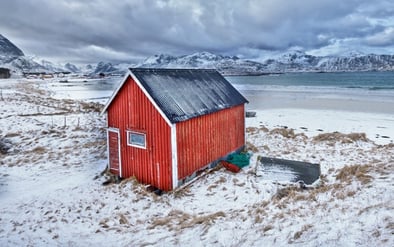Many parts of the country endure very harsh winters. Not only do temperatures drop but ice, snow and freezing rain can all play havoc on daily schedules, outdoor structures and machinery. That's why winterizing your shed will be a necessary evil if you live in the north or north east U.S.
If you have a shed or backyard structure in your yard then it's a good chance mother nature's winter wrath will have an effect on the longevity of your shed.That's why it's important to winterize your shed every winter season so it stands the test of time and you get the most use and longevity out of it.
Here are some winterization tips for your shed.
Cleaning
Before winterizing your shed you might want to consider a throrough cleaning of the shed. Since you probably use the shed to store all types of things from garden tools, lawn equipment and planting accesories, it makes sense to clean everything and then re-pack it awya organized.
- Remove and dispose of all the things you don't need including: broken tools, old seeds, damaged pots or anything no longer used.
- Sweep the floor and walls to get rid of cob webs and insect that might've made their home there.
- Empty out the garden hose and store it properly so it doesn't crack during the cold.
- Place any fertilizer, mulch, seeds or soil in indididual bags or bins. These things make a good home for any rodent or varmit looking to take shelter from the cold, plus it will prevent mildew and mold which can ruin these things.
- Empty the gas on any motorized tools like the lawnmower, weed whacker or leaf blower.
Inspect and Repair
Once the shed is cleaned out you will have an opportunity to inspect the inside walls, floor and roof of the shed for any cracks, holes or crevices. If you do find any holes or cracks, seal them up with caulk or sealant.
- Chekc the outside walls for cracks, holes or crevices. If you find any, repair with caulk or sealant.
- Check seals around the windows and doors. If you notice gaps or cracks then repair the weatherstripping and sealant around the windows. If you have shed doors that swing, keep them properly oiled so it's not a chore opening and losing the doors.

Check the Roof
The roof will require some specialized scrutiny since it does take sever punishment over the four seasons.
- Replace missing or damaged shingles.
- Look for warped wood, insect infestation, or damaged panels and replace as necessary.
- Replace any rusty or broken nails
Clear the Exterior
- Remove any plant or tree growth around the shed rubbing or touching the shed.
- Remove any debris, wood piles, leaves, grass clippings or branches that may be next to your shed. This will discourage rodents, insects and reptiles from building homes near your shed and gaining access.
- Remove any overhanging branches over the roof. It will only take one ice storm to add extra weight to that branch and make it crash down on your roof. So make sure any overhanging branches are cut back or removed.
You've invested money to have a shed in your backyard, now invest the time to get the longevity out of that investment. A simple once over every season and a few repairs and your shed will last a long time.

